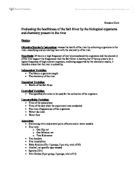Taxonomy is the science of naming and classifying organisms. There are three people that contributed to the history of taxonomy. The first one is the Greek philosopher and naturalist, Aristotle. More than two thousand years ago, he grouped plants and animals according to their structural similarities, and subdivided by habitat. Each unit of classification was called a genus, the Latin word for ‘group.” John Ray—a botanist during the early 1700’s until right before the mid 1700’s was the first to use Latin for naming names. These names were very descriptive and long because they were added to the name of the genus. These phrases sometimes consisted of 12 or more Latin words. In the 1750’s, Carolus Linnaeus—the Swedish biologist—developed a simpler system for naming organisms. He derived binomial nomenclature, a two-word system for naming organisms. The two-word name for a species is called its scientific name which must be italicized when in print, or underlined when handwritten. The Genus is the first world that is in the scientific name. The first letter is always capitalized. The species is the second word, and it is always in lowercase letters. Using scientific names creates means of communication for biologists, regardless of their native language. This also minimizes confusion, and gives the biologists a common ground of understanding. In the system of classification, derived from Linnaeus, each living thing is assigned to a series of groups that increase in inclusiveness. It starts with the species—being the last inclusive, and ends with Kingdom—the most inclusive. In order to easily identify the estimated ten to thirty million organisms on Earth, biologists must organize them by grouping the organisms into large categories that are then sorted into smaller and more specific ones.
The history of our Kingdoms system has progressed over thousands of years. It first started off about two thousand years ago when Aristotle created two kingdoms—plant and animal. Later in the 1800’s, at about 1860, Ernst Haeckel introduced the protest kingdom. The protest kingdom is single celled—containing a nucleus—which move by cilia, flagella, or amoeboid mechanisms. The kingdoms increased to five at around 1950. Herbert Copeland was responsible for adding the fourth kingdom, Monera; and Robert Whittaker added Fungi. Fungi are multicellular, contain a cell wall, contain nuclei, but have no chloroplast. They also have no means of locomotion. Monera was then broken down into Archaebacteria and Eubacteria in the 1990’s. They are unicellular, have a cell wall, have no chloroplasts and organelles, have no nucleus, and may or may not move. The domain system was proposed in the 1990’s by Carl Woese, but was accepted in 2000. The three domains are Eukarya, Bacteria, and archae. Eukarya consists of plants, protists, animals, and fungi. Domain bacteria consist of Eubacteria, and Domain Archae consists of Archaebacteria. The history of system development contributes to our world view of classifying, because it shows just how many organisms there are in our world. It also proves that things change everyday and our ways of classifying can change at any time.
Cells have evolved from many years over time. It first began with prokaryotes, which are single-celled organisms that lack a nucleus, and internal membrane-bound organelles. Prokaryotes are also known as bacteria. One of the first bacteria to appear was cyanobacteria which are photosynthetic. The cyanobacteria helped release oxygen into Earth’s atmosphere. Two groups of prokaryotes later evolved—archaebacteria and eubacteria. Archaebacteria are prokaryotes lacking peptidoglycan in their cell walls, and also have unique lipids in their cell membrane. Eubacteria prokaryotes have peptidoglycan in their cell membranes like eukaryotes. Though eubacteria have certain lipids like the eukaryotes, it is thought that the first eukaryotic cells evolved from archaebacteria about 1.5 billion years ago. Eukaryotes contain complex system of internal membranes, with DNA enclosed within a nucleus. The eukaryotic cells have mitochondrion, but only eukaryotic plant cells contain chloroplasts to carry out photosynthesis. Scientists have adopted the endosymbiosis theory proposed by Lynn Margulis in 1966 to explain the origins of mitochondria. It states that mitochondria are the descendents of symbiotic aerobic eubacteria. Mitochondria and also chloroplast have evolved through the process of endosymbiosis. It is said that bacteria entered large cells as parasites or undigested prey and began to live and perform cellular respiration and photosynthesis. Through all of this, we see just how much cells have evolved.
People classify because it is handy to have names for objects and groups of similar objects. It also helps to give scientific names because they are standardized. As the years progress, new advances in technology could help better classify organisms. If new computer programs are generated, information about the organisms can be put in one program for the world to see. This could prevent people from thinking they discovered a new organism and having a let down. Also as new organisms continue to grow, evolve, and developed, we may be forced to add a new kingdom. We do all this to make properties easier to study.
Works Cited
Smith SE. What is Biological Classification? Available at: , 2009.
Johnson GB, Raven PH. Classification of Organisms. Feldkamp S, Bowman DF. Biology-Principles & Explorations. Austin, TX: Holt, Pinenart, and Winston; 1997: 320-322
Caprette David R. Experimental Biosciences: Five Kingdom Classification system. August 13, 2007. Available at: # top. Accessed May 13, 2009.
Johnson GB, Raven PH. History of Life On Earth. Feldkamp S, Bowman DF. Biology-Principles & Explorations. Austin, TX: Holt, Rinehart, and Winston; 1997: 258-260







